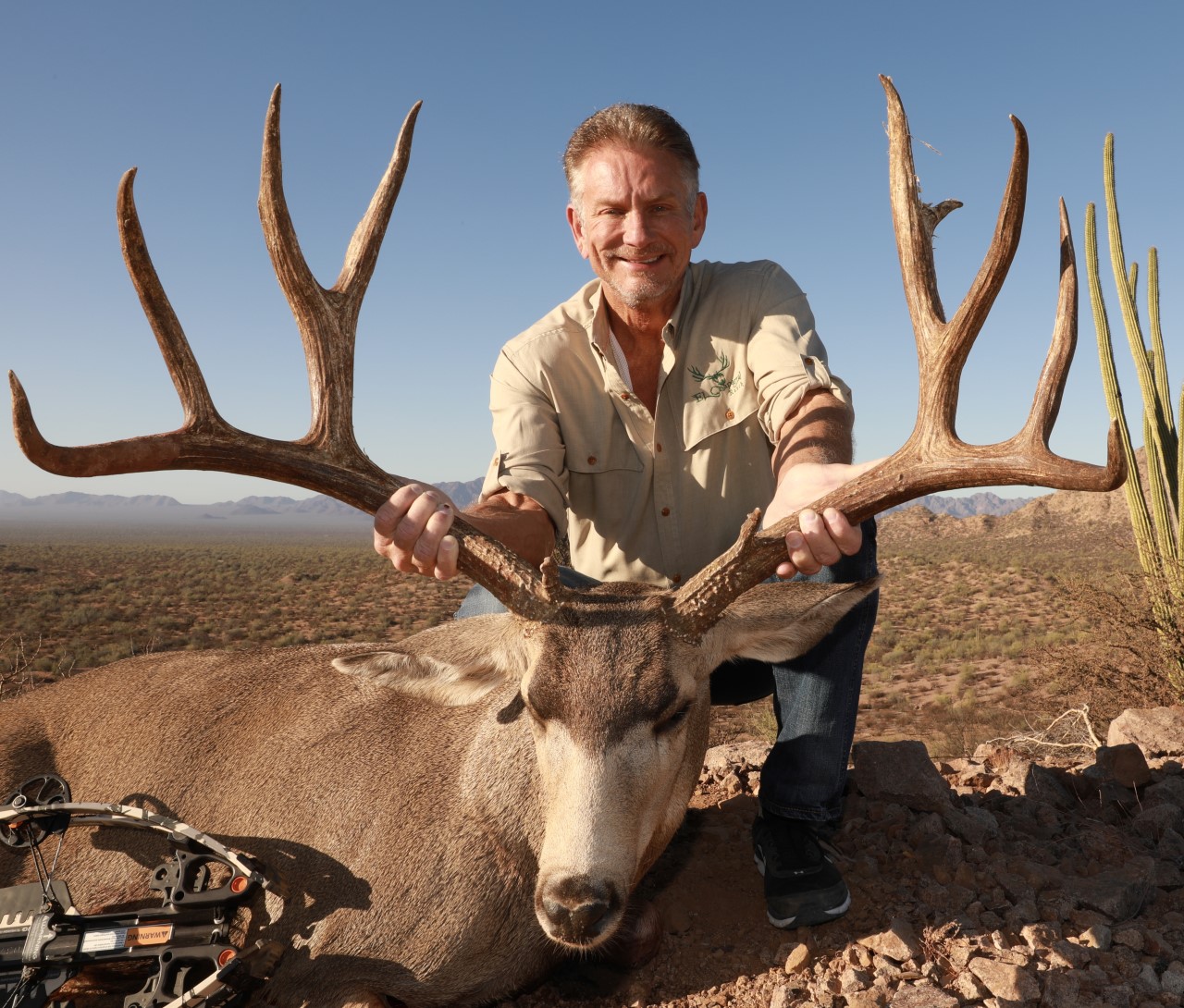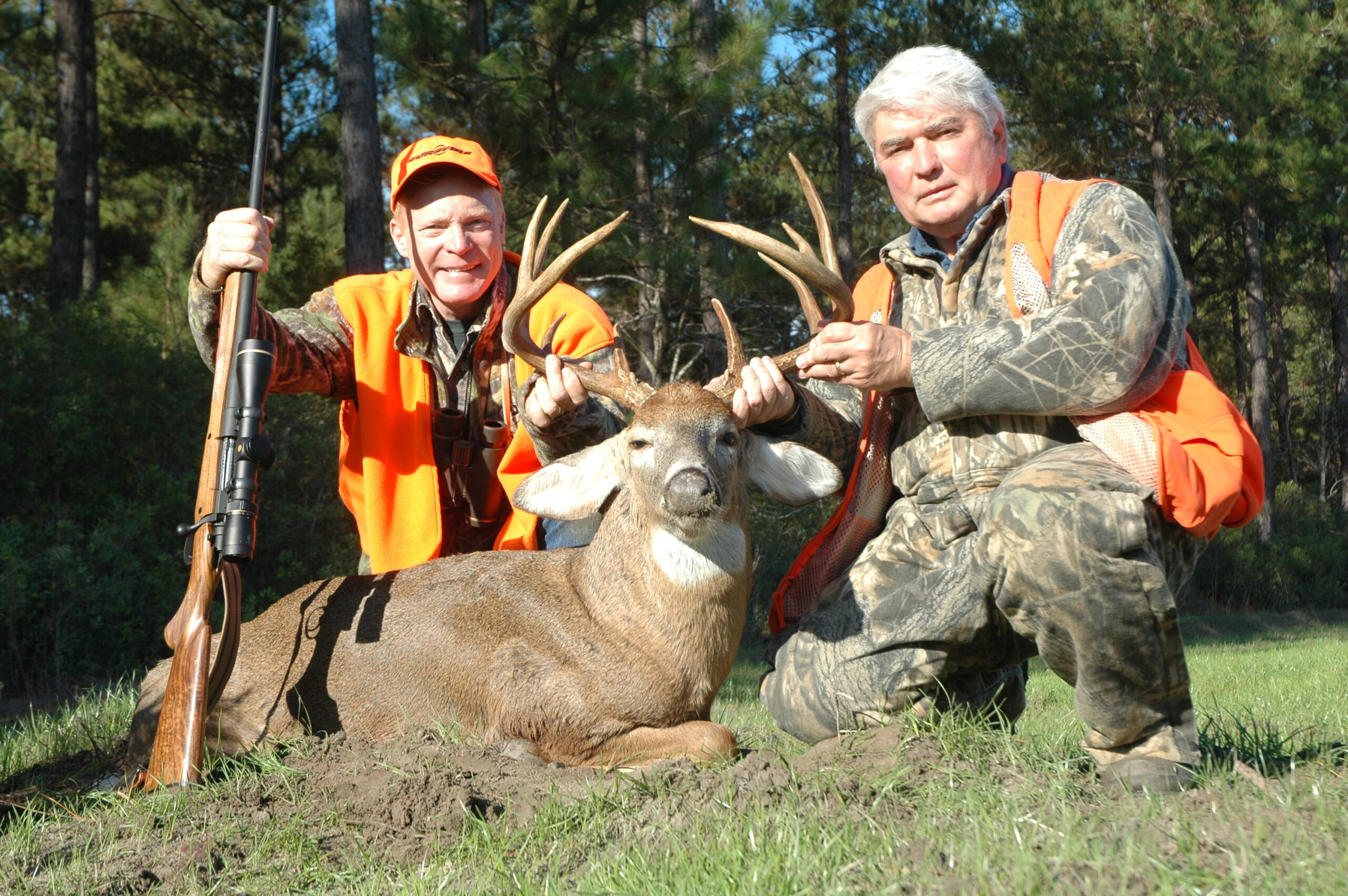The early morning fog had settled low in the mountain valley. The hulking shapes of buffalo drifted through the fog like ghostly apparitions as they left their sanctuary along the thick brush lining the dry riverbed. One by one the buffalo emerged, heading towards a clearing directly in front of us where dew laden sweet grass grew in abundance and provided good grazing. When the rising sun gradually melted away the fog, we could clearly identify 30 buffalo cows and calves grazing contentedly, oblivious to our presence. We believed a herd of females this size must certainly have a good herd bull somewhere nearby. Greg our guide, cautioned us to be alert and patient as we inched closer to the feeding herd, closing the distance to 150 yards before running out of cover. At this point, we had no option but to remain concealed in the thick bush near the clearing and wait.
We scanned with our binoculars in an attempt to pick apart every detail in every bush along the riverbed, hoping to find movement that might lead us to the bull. After 20 minutes of glassing, we observed a faint ray of sunlight reflecting off a portion of horn well hidden in the brush and then the flickering of an ear. The bull was indeed, still standing in the tree line along the dry riverbed, facing us.

It was my wife Sue’s turn on the big gun, as she slowly prepared a shooting rest. She was understandably apprehensive at first about shooting such a large creature since she witnessed earlier in the week, several buffalos taken, requiring multiple shots to bring them down. These great beasts have incredible stamina even when mortally wounded they still keep going. However, after some coaxing and understanding shot placement, she was prepared to do battle with this bull.
The cows began to graze off to our right, away from where the bull remained hidden. This forced the bull to finally emerge from the dense vegetation along the river bank and out into the open, where we could better judge trophy quality. The bull was massive, carrying at least 6 feet of magnificent horn that widened at the bases and curved backwards to form a perfect crescent. When the bull cleared the trees, he began to walk broadside towards the cows. I heard the click of the rifle’s safety go off and knew she would take the shot as soon as the bull stopped. Our guide quickly whistled to get the bull’s attention, which stopped the bull long enough for Sue to place a well-aimed round into the shoulder. The bull lurched forward at the impact and stumbled momentarily, then regained his footing and raced into the herd of cows before a second shot could be fired. Red dust filled the air obscuring our view, as cows were running everywhere. We were expecting to have a difficult tracking job sorting out where the bull had run off, but to our amazement when the dust finally settled, the whole herd had surrounded the bull lying dead in the tall grass. The cows were reluctant to leave the bull’s side, even when we approached with the safari truck. However, they eventually lost concern for the downed bull and moved off a safe distance to watch. After many photos and congratulations offered, we caped the bull and returned to camp for some much-needed refreshment and to place the hide in the salt.
This was a dream come true safari, hunting water buffalo in the Northern Territory outback of Australia with guide and outfitter Greg Pennicott. Greg is a handsome bull of a man with a devilish sense of humor that kept us all in stitches laughing throughout our trip. He has spent his entire life hunting and guiding and is well suited for life in the Australian Outback. Greg has a remarkable ability to put his clients onto huge trophy buffalo. Together, with his lovely wife Lesley, who provided delicious home cooked meals for us in camp, they make a great team.
Our hunting group consisted of my good friends Bill Miller, Patricia Ryan, Terry Bucholtz and my wife Susan. We had all hunted together in Africa, Alaska and Canada, but this was our first experience hunting the Australian Outback.
Greg recently acquired the exclusive hunting rights to the 1.5 million-acre Mary River Concession bordering the Kakadu Reserve which encompasses several million more acres of wilderness. His buffalo camps are established along a stream bank deep in the outback and consist of platform cabins which have all the amenities of electricity, hot shower and bathroom facilities courtesy of solar power. It is not unusual to see buffalo, banteng and kangaroo wander through camp grounds all hours of the day and night, grazing on grass or heading to water. Crocodiles inhabit the deeper pools in the stream next to camp and on more than one occasion we were jolted awake by the screams of some helpless creature locked in the jaws of a croc as it lingered too long at the water’s edge. We even had our own personal bush wake up alarm, when at 6:30 am each morning without fail, the Kookaburras would begin their shrill calls in the trees next to our cabin.

July is winter in the Australian outback with evening temperatures dipping into the 40’s and daytime temperatures climbing into the 80’s. We awoke each day to blue skies and sunshine without any threat of rain for at least another two months since winter is their dry season. The terrain where we were hunting is a combination of heavily forested hillsides and valleys interspersed with dense impenetrable thickets and swamps. Although water, at times, can be a scarce seasonal commodity, the Mary River Concession appears to have a steady supply in the streams and rivers that flow year-round. A blanket of thick grass carpets the forest and valley floor and can be found throughout remote clearings, attracting a variety of wildlife. buffalo, banteng, wild horses, wild boar, red and grey kangaroo and their smaller cousins the wallaby thrive in this environment, as do crocodiles and dingos. The concession has had minimal hunting pressure over previous years, which has allowed buffalo and banteng to grow to impressive size. The Mary River Concession is the only place where banteng, a wild ox, can be legally hunted and imported into the United States.
We had all taken magnificent trophy water buffalo with two days remaining on our Safari, so the decision was made to concentrate on banteng for Sue. During the course of our buffalo hunts we encountered many banteng. Several ill-tempered bulls even charged the safari vehicle. One bull in particular caught Sue’s attention. Greg described the bull as a “monster”. This banteng was unlike any of the others we had encountered during our safari. The bull had a very large body with exceptionally thick long horns tipped with polished ivory. Although the predominant color of most banteng bulls is black with white forelegs and a white rump patch, this particular bull was tan with grizzled white facial features, indicating he was a very old bull and quite a unique specimen.
Early next morning, as the sun slowly rose over the forest, we climbed a hillside and started glassing, hoping to spot the bull grazing in the clearings below. It wasn’t long before we located a group of banteng in the valley below grazing on the lush grass. Several good bulls, including the one Susan was after, were located and soon a plan was developed to sneak within comfortable shooting distance. Circling downwind of the feeding mob, we were surprised to relocate the bull smack in the middle of a herd of cows and calves. Several other good bulls had also joined the herd making it extremely difficult to remain undetected with so many eyes watching. We closed the distance to the feeding herd a number of times, but each time, the big bull would be surrounded by feeding cows and calves with no clear shot possibilities. After an hour of this cat and mouse game, the herd started to fragment and spread apart as they continued to graze from our left to our right. Using what available cover we could find, we raced in front of the grazing herd hoping to intercept the bull as he fed past at 80 yards.
Sue had found a comfortable rest for the .300 magnum rifle just as the herd began to pass through a meadow single file. The bull was last in line and as soon as he entered the clearing the 300 roared sending a 180 Nosler partition squarely into the tip of the shoulder. The impact staggered the bull who only ran a few short yards before he collapsed. We watched the rest of the herd spread out across the meadow heading towards a thick swamp. Another big black herd bull caught my attention as I watched his muscular satin black hide ripple in the morning sunlight. His horns were very long and wide, although not nearly as thick as Sue’s bull. Nevertheless, I decided he would be a worthy trophy and as soon as we confirmed Sue’s bull was down for good, the chase was on. I managed to catch up with the bull just before he entered the thick swamp. He made the fatal mistake of stopping to look back which provided enough time for me to locate him in the rifle’s scope and hit him squarely in the shoulder knocking him to the ground. He quickly regained his footing and jumped into the thick swamp.

None of us were looking forward to following an ill-tempered wounded banteng into a croc infested impenetrable swamp. After waiting a short time we followed an impressive blood trail to the edge of the swamp then climbed atop the Safari truck which provided an elevated platform enabling us to see over the tall grass. As we scanned from high atop our perch, a small patch of black became visible through the tall grass growing on a hummock. The bull had turned to face his back trail and was tucked into a thick patch of swamp grass waiting for us to approach on foot. We circled and entered the swamp downwind of the bull, trying to be as quiet as possible, as we maneuvered through the razor-sharp grass. At 20 yards, I could discern the outline of the bull facing away from us and before he could turn to charge, I fired a second round putting him down for good. The remainder of the day was spent celebrating our good fortune and giving thanks for being able to
share the success of our dream hunts with the friends and people we care about. Both banteng bulls were prepared for life-sized mounts and will be displayed at a major sporting goods store for all to see.
The Australian Outback is a magical place, full of wonder and excitement. I highly recommend a safari to this remarkable country, especially with a man as experienced as Greg Pennicott. I know I will return before too long to chase these magnificent creatures with my friend Greg.– Bob Halbritter
Bob Halbritter is a professional Taxidermist, wildlife biologist and environmental scientist who together with his wife Susan, live in upstate New York near the Canadian border on a farm where they raise American Bison.




